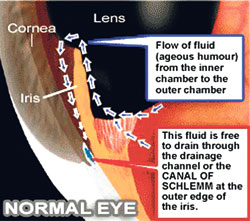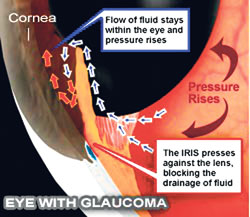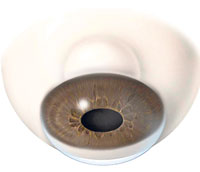Silent Thief of Vision | ||||||||||
| Glaucoma can rob you of your sight suddenly. Here Consultant Ophthalmologist Dr. Imalka Fonseka discusses the importance of early detection and treatment | ||||||||||
| By Kumudini Hettiarachchi | ||||||||||
It is the silent thief of vision. Like a thief who comes stealthily in the night and robs people of their possessions, without their knowledge, glaucoma steals up on the unsuspecting and leaves them with blindness if there is no timely detection and treatment. The tragedy, of course, is that whatever vision is lost, it is lost forever. For, glaucoma is not preventable only controllable, stresses Consultant Ophthalmologist Dr. Imalka Fonseka of the Eye Hospital in Colombo.
Explaining that in glaucoma, (except in the rarer acute angle closure glaucoma) unlike in other eye diseases, there are no symptoms, she says: "There is no pain or redness and patients don't realize they are losing their vision because once again in other conditions there is central loss of vision but here it comes from the periphery to the centre. That is why patients will not know they are carrying the disease until the advanced stages. It also doesn't affect both eyes equally." Dr. Fonseka says patients manage, even with the peripheral vision of one eye being lost due to glaucoma, because the other eye is okay. "People cope without realizing the gravity of the problem. In the west, a common complaint of drivers suffering from glaucoma is that they seem to be scraping the sides of their vehicles," she says, adding that realization dawns only when it advances to "tunnel" or worse-still "keyhole" vision.
Glaucoma, which mainly affects the aged, is seen in a shocking 4-5% of the population worldwide, MediScene learns, and with Sri Lanka heading towards an ageing population this should be one disease, which needs much attention. Grouping adult glaucoma into "acute" which is rare and has symptoms such as eye pain, halos around lights at night, blurred vision due to sudden high eye or intraocular pressure, Dr. Fonseka underlines the fact that "chronic" glaucoma is more worrisome and is the most common form of glaucoma. Just after 40, when you find it difficult to read without glasses (presbyopia). That is the ideal time to check out whether you are coming in for glaucoma, says Dr. Fonseka, explaining that as awareness seems to be the biggest problem not only eye doctors but also opticians are now being trained to check the back of the eye, the head of the optic nerve, to catch the early signs of glaucoma. "If, however, there is a family history of glaucoma," reiterates Dr. Fonseka, "regular check-ups before 40 are a must. When a family member is diagnosed with glaucoma, every sibling and every child of that person must get their eyes checked." What are the causes of glaucoma? Those days although it was believed that glaucoma was caused by high intraocular pressure, and it was essential to have high intraocular pressure to diagnose glaucoma, at present it is only an important risk factor. This is because a larger percentage of glaucoma patients have been found to have normal intraocular pressure ie. normal tension glaucoma, explains Dr. Fonseka. Hence the most important danger sign is "glaucomatous cupping" and thinning of the nerve fibre layer of the retina. That's why when screening the population it is not only important to check eye pressure and the visual field but also vital to look at the optic nerve head itself, she says. According to a hospital-based survey carried out by Dr. Fonseka, 60% of all glaucoma patients had normal tension (pressure) glaucoma while only 32% had high tension in the eye (causing open-angle glaucoma). Eight percent had angle-closure glaucoma.
When eye pressure rises, the right amount of fluid cannot drain out of the eye and thus the eye's drainage canals get clogged. If the opening of the drainage canals are clogged it causes angle-closure or acute glaucoma, while in other cases though the entrances to the drainage canals are clear, the clogging occurs inside resulting in open-angle glaucoma, MediScene learns. Even the visual field checks may come a little too late because by the time glaucoma is diagnosed through visual field tests, the victim may have already lost 40-50% of optic nerve fibres. The optic nerve combines the eye to the brain and carries images between them. It is like a cable with 1 or 1.5 million separate wires or nerve fibres connecting both. Like people shed a certain number of hairs daily, there is a slow progression of death of the nerve fibres in normal life. This is natural, says Dr. Fonseka, adding that usually a 70-year-old will have only 70% of nerve fibres. "But in glaucoma patients there is an exaggerated loss of optic nerve fibres. There is no cure for loss of nerve fibres but we can slow-down this exaggerated loss through early detection and treatment," she says. How is glaucoma treated? The first line of treatment is medication in the form of eye drops. "Prostaglandin analogues, a powerful drug, though very expensive, has revolutionized the management of glaucoma by bringing down intraocular pressures to very low levels and can preempt surgery," she says. If it fails to achieve the targeted eye pressure, which is determined on a one-to-one basis, then laser treatment may be an option. The gold standard, of course, is filtration surgery where an artificial passage is created in the eye to drain fluid and bring about normal eye pressure," she adds. The treatment is to retard further loss of vision which otherwise would lead to blindness, explains Dr. Fonseka, stressing that the essential requirements from the patient would be compliance and lifelong follow-up. Then patients can lead near-normal lives. "Don't ever stop the treatment," she advises. The risk factors:
| ||||||||||
-- The Sunday times - LK

























































No comments:
Post a Comment